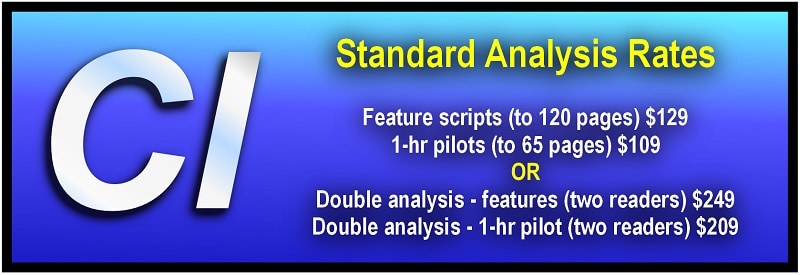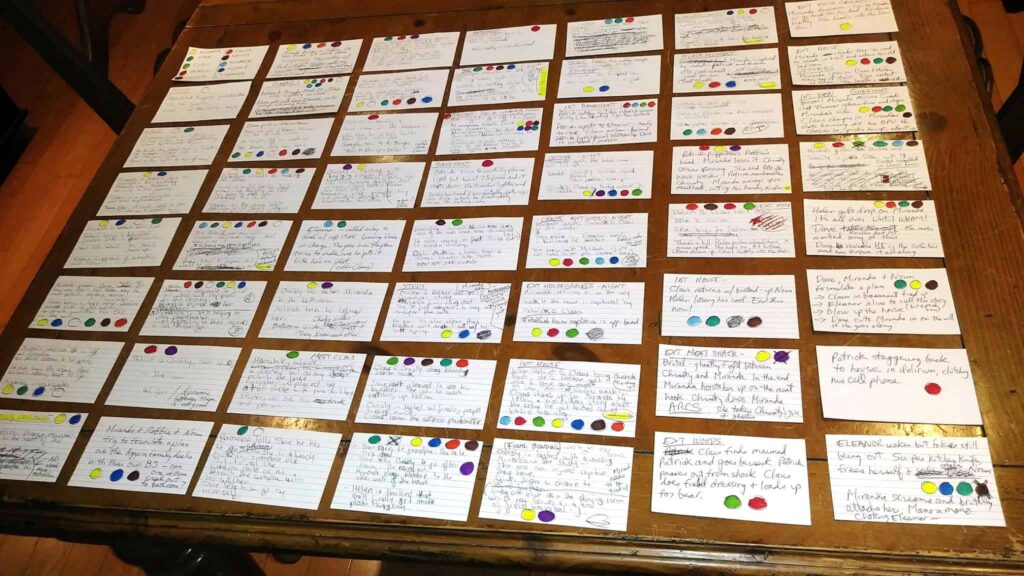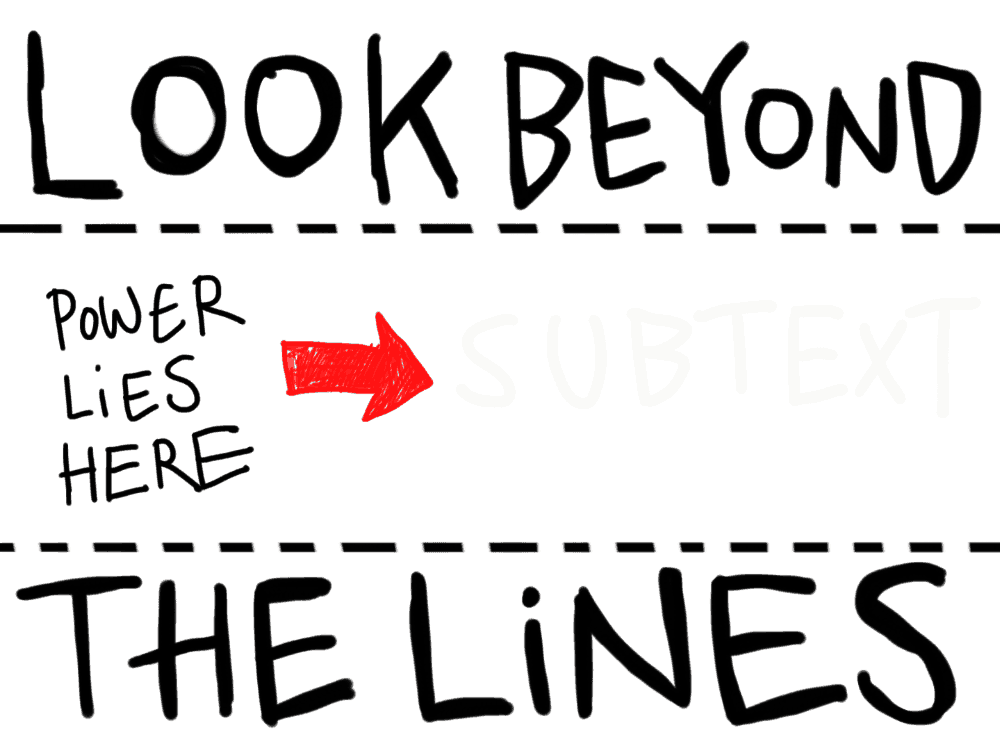
WINNERS
First Place: HOUSE ON THE BORDERLAND (feature) by Eric Steele
First Runner Up: KEY TO THE CASTLE (feature) by Thomas Hawgood & Lexi Rose
Second Runner-Up: SADHBH (pilot) by Marnie Collins
Congrats to our amazing winners! You guys really knuckled down and brought it.
The CI 30-Day Screenwriting Challenge will return…

April 1 through 30, 2020
Are you up for THE CHALLENGE?
Have you got what it takes?
Can you knuckle down and crank out a first draft of a brand-new feature or pilot IN 30 DAYS?
Damn right you can.
Welcome to the CI 30-Day Screenwriting Challenge.
Sorry, the March 30th entry deadline has passed.
The CI 30-Day Screenwriting Challenge is currently closed.

How Does It Work?
1. Register by 3/30/2020.
2. Submit 5 – 10 loglines (your new ideas) for either a feature or a pilot to Coverage Ink.
These must be NEW ideas! Loglines for existing screenplays previously submitted to CI, to other coverage companies, or circulated around town in any way will be disqualified. The idea is to challenge yourself to write something brand-spankin’-sparkly in 30 days. We’ll e-mail you after you register with all the info you need.
3. On March 31st, CI will e-mail you with the logline we have selected for you to write.
You then have 30 days to write and submit a draft. You must use the logline selected by CI to participate in the Challenge.
4. All drafts must be submitted to CI for analysis no later than midnight on April 30th.
Standard coverage rates apply (since you’ll be getting standard coverage.)
Then on April 30th, click the big blue SUBMIT IT button at the bottom of this page (or the CI home page page) when you’re ready to rock.
5. CI selects the winners.
This will hopefully happen around the first week of May. During the writing period, we will also send you weekly motivation and advice and remind you of milestones you should be hitting. You can also email us with your questions should you get stuck or feel writer’s block coming on, or simply for advice and encouragement.


PRIZES

FIRST PLACE: $500
plus 1 YEAR SUBSCRIPTION at TrackingB.com
SECOND PLACE: $200
plus 1 YEAR SUBSCRIPTION at TrackingB.com
THIRD PLACE: $150
plus 1 YEAR SUBSCRIPTION at TrackingB.com
![]() TRACKINGB.com is the #1 Hollywood tracking board used by the industry to share information. This is where they talk about specs that are going out (and the reactions,) who’s looking for what, executive hirings and firings, and so forth — all from deep in the trenches. If you think this could be extremely useful intel for screenwriters, you’re right. Plus TrackingB.com has the best contests around — every year, their TV and feature contests get writers signed and launch careers. Their track record is insane. In fact, their 2020 TV pilot contest is on right now. Visit TrackingB.com. Each subscription is a $99 value.
TRACKINGB.com is the #1 Hollywood tracking board used by the industry to share information. This is where they talk about specs that are going out (and the reactions,) who’s looking for what, executive hirings and firings, and so forth — all from deep in the trenches. If you think this could be extremely useful intel for screenwriters, you’re right. Plus TrackingB.com has the best contests around — every year, their TV and feature contests get writers signed and launch careers. Their track record is insane. In fact, their 2020 TV pilot contest is on right now. Visit TrackingB.com. Each subscription is a $99 value.
EVERYONE WHO FINISHES and submits their draft to Coverage Ink for analysis by April 30th gets a free ½ hour phone or Skype consultation with one of the CI management team (Jim, Tanya, or Anna). Discuss your project, your career, how to get where you want to be – whatever you like.
INCREDIBLE FEELING OF ACCOMPLISHMENT. This might be just the kick in the rump you need! We all need deadlines to be our most productive. We all procrastinate; we all prioritize silly things like “family” or “work” over our writing. Well, no longer! Prove to yourself you can do this! You can have a new piece of material in just 4 weeks if you knuckle down and grind. Not only will this give you an exciting new piece of material, benefiting from everything you’ve learned about screenwriting to date, but it should shake out the cobwebs and recharge your batteries. Win/win.
And of course, everyone who submits also gets a full CI story analysis (which you pay for). Even if you’re not a Challenge winner, the notes in the analysis should empower you with great ideas to make the next draft better, stronger, faster.

RULES
- You must write a NEW script in 30 days. Anything previously submitted to CI, other services, or contests, etc. will be automatically disqualified.
- Deadline to enroll and and submit your 5-10 loglines is March 30, 2020. You may enroll after April 1st, but you must still submit your draft by April 30th to participate in the Challenge.
- Scripts submitted after April 30th will still be evaluated as regular coverage submissions.
- CI will select the project you write based on the 5 – 10 new loglines you submit. The feature script or pilot you submit at the end of the Challenge must be based on the logline CI selects for you. Of course, you are welcome to write something else and submit it for coverage anytime, but it won’t be entered into the Challenge.
- All completed screenplays and 1-hr pilots must be submitted to CoverageInk.com for coverage by April 30th to qualify for the Challenge. Unfinished screenplays/pilots (under 85 pages for a feature and under 45 pages for a 1-hour pilot) will be disqualified.
- The opinion of the CI readers is final. There are no refunds. You are entitled to disagree with the analysis as a whole or in part, but you disagreeing with the reader’s opinion is not grounds for a refund. Of course, we urge you consider all the notes carefully, especially the ones that “hurt” the most. Those are often the most important ones, the ones that require some real elbow grease.
- CI does not in any way own or obtain any rights to your material. At no point do any rights or “chain of title” change hands. Your work is your work. We’re just evaluating it and telling you own opinion.
- You are free to do with the analysis as you see fit – including nothing. However, we hope you use the notes to help make your next script kick butt.
- You may submit works in progress to CI for coverage during the challenge (including outlines, etc.) These will be evaluated separately, and standard submissions. Email us for quotes or info.
- If you don’t finish/submit your draft in time, you will not get a free consult. But you may submit the draft for coverage at any time.
- Offer open to everyone over the age of 18 worldwide where permitted.
- All genres are accepted. We will pair your submission with a reader who specializes in that style (we have 32 readers.)
- Screenplay and teleplay submissions must be in industry standard format and must be submitted in either PDF or Final Draft format.
- Coverage Ink team members, partners and associates are not eligible.
- E-mail follow-up questions are free up to appx. 10 minutes of the reader’s time. For more in-depth follow-ups we’re happy to schedule a phone or Skype consultation with the reader.
- 1-hour pilots are eligible; ½-hour pilots are not. Sorry!
- Screenplays over 130 pages and pilots over 70 pages are not accepted. Edit ruthlessly.
- Challenge winners are selected by the following methods:
- All scripts that score a “consider with reservations” or better for script will be in the running.*
- CI senior staff Jim Cirile, Tanya Klein and Anna Siri will confer with the readers to see which scripts/pilots they loved, which ones were on the bubble, etc.
- Based on the above, we will select the finalists. These will be read by the senior staff.
- Jim, Tanya and Anna will select the winners. Their opinion is final.
*In script coverage, scripts are rated the following for both SCRIPT and for WRITER: Pass, Consider with Reservations, Consider, Strong Consider, and Recommend. Most scripts submitted for coverage will be a “pass” (around 70% or more.) This doesn’t mean that the material has no merit; it simply means it’s not in the zone yet (that’s what rewrites are for.) “Consider with Reservations” (or higher) means the script is already in decent shape or has some qualities that make it worth a look. Please note that a “Consider with Reservations” for WRITER does not count for the 30-Day Challenge — only “Consider with Reservations” for SCRIPT.
Note that ratings of “Consider” or higher for script are very rare, especially on first drafts! It’s unlikely we will get any (but hey, you never know.) As for “Recommend,” those are unicorns. Don’t feel too upset if you don’t get one. It may take a lot of drafts and elbow grease just to get into the ‘consider’ zone, which is where most specs circulated around Hollywood are.
In the event that we do not recent three scripts or pilots which score “consider with reservations” for script, we will choose the best of the near-miss passes as selected by our readers.

WAYPOINTS
Watch this video with tips and motivation to get started!

End of Week one (April 7th)
 FEATURES: Your goal is to have an outline done by week’s end. This outline should have enough depth that you know all the main beats, possibly some partial scenes. We highly recommend using the Save the Cat! beat sheet.
FEATURES: Your goal is to have an outline done by week’s end. This outline should have enough depth that you know all the main beats, possibly some partial scenes. We highly recommend using the Save the Cat! beat sheet.
You should also aim to have detailed character bios for your main characters – think about who these people are, their backstories, peccadilloes, socio/economic status, significant life events, tragedies, successes, strengths, flaws, quirks, neuroses, medical issues, dramatic flaw, politics, education, personality type, and most importantly: main want. The better you know your characters, the easier it will be to write them, and the more character-specific their dialogue will be.
Finally, don’t forget THEME. WHY are you telling this story? What is it really saying — what’s the takeaway? Show us what your story is about, what it’s trying to say through the protagonist’s experience and through what they need to learn.
 TV: Much of the above still applies. Whether you are writing a 4, 5 or 6-act script (regardless of whether or not you use act breaks on the page,) aim to have your outline done by end of week one, along with character bios. If you have an overall idea for the series direction, write that down, too. That will inform your long-term storytelling and can eventually become the bible (which you do not need yet — but you do need to have an overview of where your whole first season is going. Figure out your act breaks in advance as well, and make sure you end acts on either a cliffhanger or an emotional high point or a plot twist.
TV: Much of the above still applies. Whether you are writing a 4, 5 or 6-act script (regardless of whether or not you use act breaks on the page,) aim to have your outline done by end of week one, along with character bios. If you have an overall idea for the series direction, write that down, too. That will inform your long-term storytelling and can eventually become the bible (which you do not need yet — but you do need to have an overview of where your whole first season is going. Figure out your act breaks in advance as well, and make sure you end acts on either a cliffhanger or an emotional high point or a plot twist.
It is crucial that you employ an A-B-C or A-B-C-D structure — that means “A” story belongs to the protagonist, and then we have at least two subplots which go to the ensemble. TV shows are mostly ensembles — they rarely are “A” story only. That’s for features. If your pilot follows a single storyline from beginning to end, that’s called a “movie.” By all means, keep the focus on the protagonist, but use the subplots to flesh out the secondary characters as well as to shed light on the protagonist.
The flip s ide of that is if your show is a TRUE ensemble — in other words, you have a lot of characters, and each character and subplot gets the same amount of screen time — let’s say a few minutes each — that’s also a fail, at least as far as specs are concerned. We need a star role. Sure, “Game of Thrones” got away with this, but you cannot. Here’s a good metric to follow:
ide of that is if your show is a TRUE ensemble — in other words, you have a lot of characters, and each character and subplot gets the same amount of screen time — let’s say a few minutes each — that’s also a fail, at least as far as specs are concerned. We need a star role. Sure, “Game of Thrones” got away with this, but you cannot. Here’s a good metric to follow:
A Story: 60% of screen time; B story: 25% of screen time; C story: 20% of screen time, and D story (this may be just a ‘runner’ with a simple beginning, middle and end): 5% of screen time.
Important: It’s best to avoid PREMISE PILOTS (AKA an origin story, AKA ‘pilotitis.’) Of course you can have some origin in there, but if it goes on past Act 1, it’s a tough sell as a spec. You must demonstrate the series engine in your pilot, which means: it must represent a typical episode — in other words, show us what we’re going to get week after week. Origin stories do not do that. Look to the BREAKING BAD pilot for a great balance between origin/setup and typical episode.
Finally, act breaks are not necessary for 1-hr pilots — provided you are aiming at streaming. If you think the show could work for network or basic cable, make sure to include act breaks. In other words, you have a lot more possible places that can make your show if you include them; plus it demonstrates that you can write the form.

Breaking down your story on color-coded cards can be super helpful for seeing the big picture at a glance.
End of Week 2 (April 14th)
 FEATURES: Aim to have Act 1 in the can. This is a relatively short act, and the structural waypoints are pretty well-established (protagonist in his/her known world; inciting incident; protagonist refuses the call; etc.) So this one should be doable in a week. 5 pages a day will get it done. And don’t forget to go back and re-read and revise constantly.
FEATURES: Aim to have Act 1 in the can. This is a relatively short act, and the structural waypoints are pretty well-established (protagonist in his/her known world; inciting incident; protagonist refuses the call; etc.) So this one should be doable in a week. 5 pages a day will get it done. And don’t forget to go back and re-read and revise constantly.
If you have additional time, it may be helpful to break down your entire structure scene by scene using color-coded index cards. This is enormously helpful in seeing the entire structure from 20,000 feet, and spotting troublesome things like your protagonist disappearing for huge chunks of time.
 TV: Whether you’re writing a 4-6-act pilot or whatever, aim to have the teaser and up to around page 15 finished by end of week one. This is seemingly an “easier” ask than on the feature side just by page count. However: a great teaser should be a masterpiece of conciseness. It should convey the tone and theme of the show (again, check out BREAKING BAD’S brilliant teaser that sets the timbre for the entire series, all in an exciting, baffling, and tantalizing way.)
TV: Whether you’re writing a 4-6-act pilot or whatever, aim to have the teaser and up to around page 15 finished by end of week one. This is seemingly an “easier” ask than on the feature side just by page count. However: a great teaser should be a masterpiece of conciseness. It should convey the tone and theme of the show (again, check out BREAKING BAD’S brilliant teaser that sets the timbre for the entire series, all in an exciting, baffling, and tantalizing way.)
Edit ruthlessly. Begin scenes late and get out early. Every paragraph, every line, every single word must FIGHT for its inclusion on the page. If you CAN cut it, then it must be cut. Be brutal!
End of Week 3 (April 21)
 FEATURES: This is the hardest week. Act 2 is the biggest, toughest act. It may run anywhere from 45-70 pages. It’s also the toughest one structurally (you are following the aforementioned Save the Cat! beat sheet, aren’t you?)
FEATURES: This is the hardest week. Act 2 is the biggest, toughest act. It may run anywhere from 45-70 pages. It’s also the toughest one structurally (you are following the aforementioned Save the Cat! beat sheet, aren’t you?)
BUT: by the time you get here, you’ll be in high gear, and 8 pages a day should be no problem. Don’t forget your midpoint, your protagonist gradually becoming aware of their character flaw (which they still cannot solve yet) by the end of act 2, and end the act with the Dark Night of the Soul, AKA the Black Moment, aka Whiff of Death — after a massive setback, your protagonist should be at the furthest possible point from their goal.
 TV: Your goal is to have Acts 2 and 3 completed, and do a revision/editing/dialogue pass as well. If you have time, by all means proceed into Act 4.
TV: Your goal is to have Acts 2 and 3 completed, and do a revision/editing/dialogue pass as well. If you have time, by all means proceed into Act 4.
Don’t be afraid of the “vomit draft” — just get it down on however you can, messy and malformed and clunky though it may be. That’s fine. You can tighten and revise at any point. You should feel the wind at your back now — onward!
End of Week 4 (April 28)
 FEATURES: Nail down that final act and write THE END. Whew! Now you have two days left to proofread, spell-check, revise, and make it rock. Get some fast feedback from trusted friends, advisors, writing group or class.
FEATURES: Nail down that final act and write THE END. Whew! Now you have two days left to proofread, spell-check, revise, and make it rock. Get some fast feedback from trusted friends, advisors, writing group or class.
Now go back. See that part there you just skipped over — PROOFREAD and SPELL-CHECK? Do it, Hawkeye!

TV: Button up acts 4 and 5 or 4, 5 and 6. Use the remaining two days to get quick feedback if possible and of course proofread.

IT’S APRIL 30th – READY TO SUBMIT?
Hold up! Ask yourself the following:
 Is your protagonist or series lead compelling, dimensional and fascinating?
Is your protagonist or series lead compelling, dimensional and fascinating?- Have you edited ruthlessly? Have you spell-checked and proofread?
- Is your theme coming through? Do we know what it is that this feature or series is really saying?
- Is your voice, your originality, on the page? What is it about your writing, your style, your panache that will hook the reader on page one? Make sure your talent hits like a fist to the jaw.
- Are you using subtext? Body language? Are you avoiding direct exposition except when absolutely necessary?
- Are you showing, not telling?
- Pilots: Can you see this airing on a specific streaming platform or network? Does it “fit in” with what’s out there? Will agents and managers know how to sell it?
- Pilots: Have you ended each act on a cliffhanger or high point?
- Pilots: Does the pilot resolve at least one of the stories (subplots) while still allowing the overarching story to continue?
Done? AWESOME.
Submit it at coverageink.com or click the button:





